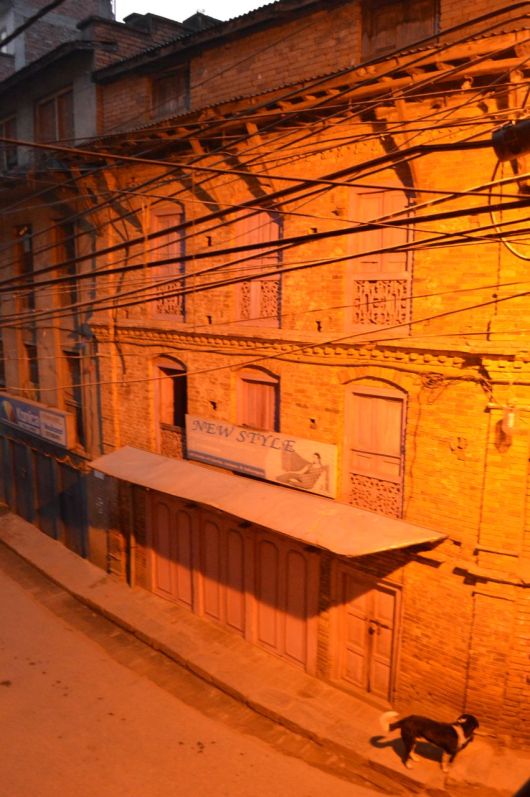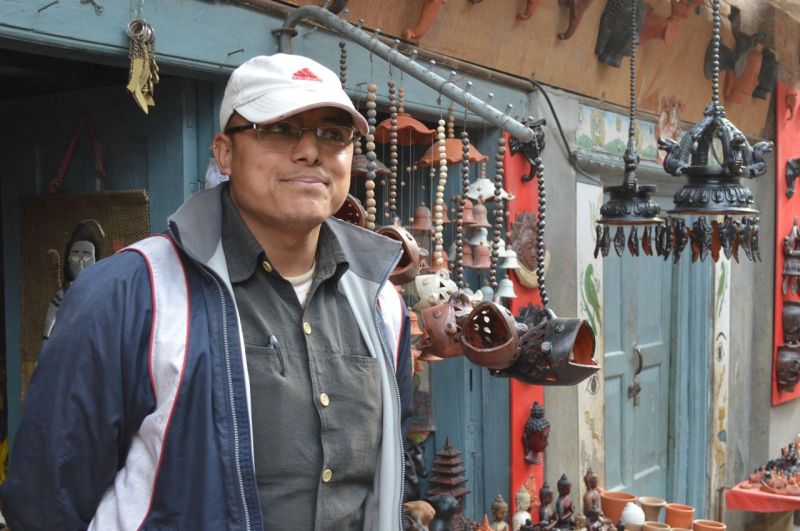We have settled into a lovely rhythm in our one-bedroom apartment and in the small and ancient town of Bhaktapur. We are about 2min walk from the city gate that opens into Durbar Square – the largest square of the town. Durbar Square is home to stunning architecture, temples, carvings, the art gallery and restaurants; it is also meeting place for friends to gather to catch up on the day’s events.
Timber resting places, most of which have highly decorative woodwork, are a common feature of Newari architecture. (The Newā people or Newārs are the indigenous people of the Kathmandu Valley and the creators of its historic civilization). They are found in Durbar Square, throughout Bhaktapur and other similar towns and look like a blend of platform, stage and market stall. They are a generous offering to residents and guests to sit, rest and meet. During the evening we enjoy hearing the quiet hum of hundreds of voices in conversation as the dark and unlit square is infused with life and human interaction. There is little other noise.
Our road is narrow. Three, four and five storey houses hem either side; houses meet the street with a shop, the contents of which very often spill out and invite inspection. It a thoroughfare for walkers, tractors, motor bikes, wedding parties and the occasional car.
The street comes to life early – I awake to the sound of the road being swept, not by the industrial street sweeper we know, but with the rhythmic sound of the brush broom across the rough surface. I picture the person bent over with one hand resting on their back, walking and sweeping with a regular swoosh swoosh.

Early morning, before the street begins to rouse.
It’s hard to be clean in Nepal; it is dusty and has unreliable power and water supplies – but residents are committed sweepers. We soon hear chatter, the sounds of shops being opened and students heading off to school. By the time we get up at 7.30 the morning rush is over.
On our little street everything we could possibly need is available – shoes, mobile phones, food and clothes, electrical goods, pharmaceuticals. We can have our photos taken, printing done, get a haircut, or worship if we were so inclined. We can step out the front door and get whatever is required without involving a car or a bus, and definitely not a supermarket or shopping centre. All this is typical of all the towns and cities we have visited in Nepal and one many things we love about being here.
At the other end of the street is a Pokhari – a large brick pond. These large bodies of water are also commonly seen in Bhaktapur and provide a place for walking, gathering and resting. In the past the Pokhari was the local water supply for the daily needs of the nearby residents. At the other end of our day, we too enjoy a quiet stroll around the Pokhari.
Whilst I start to prepare our breakfast – coffee of course, and cereal, Jyoti goes downstairs to buy supplies. Jyoti loves this daily ritual of joining the life of the street and has got to know the local sellers who like to teach him a few Nepali words as well as share their political view. He buys fresh apples, bananas and King Curd – a local and much loved form of yoghurt. We enjoy lashings of it on our cereal. Our local breakfast is a perfect start to our day – both in its preparation and eating.
King Curd is made and sold in a hand made clay dish, another reason we love it. Pottery is another speciality of the town and has been for generations. The dishes are made about ten minutes walk from here atN, also known as Pottery Square. The area is a feast for the eye. Artisans work on huge timber wheels that sit on the ground and are spun using a long pole. Bending over a mound of rich black clay, harvested from the hills around the town the potters turn out pots that are spread out on the square to dry and be finished. The range is small, and apart from the functionary yoghurt dishes, we see small lamps for pujas, and 1000s of moneyboxes – which we have yet to work out why – being made.
When we were last in Bhaktapur we met one of the artisans, a man named Binod, who showed us his studio and sculptures. We were delighted to meet him again. He explained the traditional process of creating and firing the pottery, as well as how the all the family is involved; pottery is one of the castes here. He invited me to come and exchange skills with him. A few weeks’ ago I had my first experience of creating on a wheel made from an old tyre.
Although these ancient practices look wonderful to an outsider’s eye, for the artisans and their families, pottery can be an arduous and heavy job, and at times dangerous. Digging and preparation of the clay is done by hand; as the pits are deep in the ground now and not as easily accessible as they once were, there is increased risk in this task. We learned from another ex-potter that until quite recently, potters wielded a great deal of power over farmers. They were able to harvest clay from the farmland – without permission and without regard for the crops or the farmer’s livelihood. Rather reminded us of the fracking debate.
We watch as large lumps of clay are kneaded into a suitable consistency for throwing and small stones and other imperfections removed. Much of the preparation is hand-done largely because of the erratic power supplies. Binod told us there are electric wheels for when there is power, and a pug mill for processing the clay has recently been acquired.

Behind Pottery Square and next to Binod’s house/studio and shop are the two communal wood/straw fired kilns. Each runs on a 3-day cycle : packing hundreds of pots in layers of straw, covering with a blanket of ash and an outer layer of tin, firing, cooling and unpacking. The firing takes a day and a night; kilns are gently fed timber and carefully monitored. At the end of the firing, a warm layer of ash provides a very cozy bed for the local dogs.
The low-temperatures reached in the kiln leaves the pots a brownish-terracotta colour, very porous and not terribly durable. Pottery is a throw-away item here. Yet as each plate that is licked clean of the delicious King Curd is handmade and unique, neither of us is willing to throw it in the bin. Consequently our small kitchen has a dish with spices, another for fruit, another for vegetables, another for sponges, there is one in the bathroom for soap, we serve our rice in yet another. But after three weeks here we had to give in and throw some out. They will end up on the street, broken and crushed – to be swept away by the morning sweeper.







